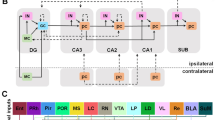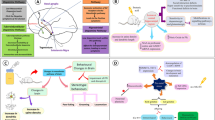Abstract
Soluble epoxide hydrolase (sEH), an enzyme with COOH-terminal hydrolase and NH2-terminal lipid phosphatase activities, is expressed in regions of the brain such as the cortex, white matter, hippocampus, substantia nigra, and striatum. sEH is involved in the regulation of cerebrovascular and neuronal function upon pathological insults. However, the physiological significance of sEH and its underlying mechanism in modulating brain function are not fully understood. In this study, we investigated the role of sEH in anxiety and potential underlying mechanisms in mice. Western blot for protein phosphorylation and expression was performed. Immunohistochemical analyses and Nissl and Golgi staining were performed for histological examination. Mouse behaviors were evaluated by open field activity, elevated plus maze, classical fear conditioning, social preference test, and Morris water maze. Our results demonstrated that the expression of sEH was upregulated during postnatal development in wild-type (WT) mice. Genetic deletion of sEH (sEH−/−) in mice resulted in anxiety-like behavior and disrupted social preference. Increased olfactory bulb (OB) size and altered integrity of neurites were observed in sEH−/− mice. In addition, ablation of sEH in mice decreased protein expression of tyrosine hydroxylase and reduced dopamine production in the brain. Moreover, the level of phosphorylated calmodulin kinase II (CaMKII) and glycogen synthase kinase 3 α/β (GSK3α/β) was higher in sEH−/− mice than in WT mice. Collectively, these findings suggest that sEH is a key player in neurite outgrowth of neurons, OB development in the brain, and the development of anxiety-like behavior, by regulating the CaMKII-GSK3α/β signaling pathway.









Similar content being viewed by others
References
Gill SS, Hammock BD (2009) Distribution and properties of a mammalian soluble epoxide hydrase. Biochem Pharmacol 29:389–395
Enayetallah AE, French RA, Thibodeau MS, Grant DF (2004) Distribution of soluble epoxide hydrolase and of cytochrome P450 2C8, 2C9, and 2J2 in human tissues. J Histochem Cytochem 52:447–454
Johansson C, Stark A, Sandberg M, Ek B, Rask L, Meijer J (1995) Tissue specific basal expression of soluble murine epoxide hydrolase and effects of clofibrate on the mRNA levels in extrahepatic tissues and liver. Arch Toxicol 70:61–63
Sura P, Sura R, Enayetallah AE, Grant DF (2008) Distribution and expression of soluble epoxide hydrolase in human brain. J Histochem Cytochem 56:551–559
Zhang W, Koerner IP, Noppens R, Grafe M, Tsai HJ, Morisseau C, Luria A, Hammock BD et al (2007) Soluble epoxide hydrolase: a novel therapeutic target in stroke. J Cereb Blood Flow Metab 27:1931–1940
Wang J, Fujiyoshi T, Kosaka Y, Raybuck JD, Lattal KM, Ikeda M, Herson PS, Koerner IP (2013) Inhibition of soluble epoxide hydrolase after cardiac arrest/cardiopulmonary resuscitation induces a neuroprotective phenotype in activated microglia and improves neuronal survival. J Cereb Blood Flow Metab 33:1574–1581
Spector AA, Fang X, Snyder GD, Weintraub NL (2004) Epoxyeicosatrienoic acids (EETs): metabolism and biochemical function. Prog Lipid Res 2004(43):55–90
Inceoglu B, Jinks SL, Ulu A, Hegedus CM, Georgi K, Schmelzer KR, Wagner K, Jones PD et al (2008) Soluble epoxide hydrolase and epoxyeicosatrienoic acids modulates two distinct an algesic pathway. Proc Natl Acad Sci U S A 105:18901–18906
Lee J, Dahl M, Grande P, Tybjaerg-Hansen A, Nordestgaard BG (2010) Genetically reduced soluble epoxide hydrolase activity and risk of stroke and other cardiovascular disease. Stroke 41:27–33
Iliff JJ, Alkayed NJ (2009) Soluble epoxide hydrolase inhibition: targeting multiple mechanisms of ischemic brain injury with a single agent. Future Neurol 4:179–199
Wang SB, Pang XB, Zhao Y, Wang YH, Zhang L, Yang XY, Fang LH, Du GH (2012) Protection of salvianolic acid on rat brain from ischemic damage via soluble epoxide hydrolase inhibition. J Asian Nat Prod Res 14:1084–1092
Poli G, Corda E, Martino PA, Dall’ara P, Bareggi SR, Bondiolotti G, Iulini B, Mazza M et al (2013) Therapeutic activity of inhibition of the soluble epoxide hydrolase in a mouse model of scrapie. Life Sci 92:1145–1150
Wang SB, Pang XB, Gao M, Fang LH, Du GH (2013) Pinecembrin protects rats against cerebral ischemic damage through soluble epoxide hydrolase and epoxyeicosatrienoic acids. Chin J Nat Med 11:207–213
Zhang W, Davis CM, Edin ML, Lee CR, Zeldin DC, Alkayed NJ (2013) Role of endothelial soluble epoxide hydrolase in cerebrovascular function and ischemic injury. PLoS One 8:e61244
Strauss KI, Gruzdev A, Zeldin DC (2013) Altered behavioral phenotypes in soluble epoxide hydrolase knockout mice: effects of traumatic brain injury. Prostaglandings Other Lipid Mediat 104-105:18–24
Lissek S, Kaczkurkin AN, Rabin S, Geraci M, Pine DS, Grillon C (2013) Generalized anxiety disorder is associated with overgeneralization of classically conditioned fear. Biol Psychiatry 75:909–915
Barlow DH (2000) Unraveling the mysteries of anxiety and its disorders from the perspective of emotion theory. Am Psychol 55:1247–1263
Adhikari A (2014) Distributed circuits underlying anxiety. Front Behav Neurosci 8:112
Robinson HM, Hood SD, Bell CJ, Nutt DJ (2006) Dopamine and social anxiety disorder. Rev Bras Psiquiatr 28:263–264
Bodea GO, Blaess S (2015) Establishing diversity in the dopaminergic system. FEBS Lett 589(24 Pt A):3773–3785
Atanasova B, Graux J, El Hage W, Hommet C, Camus V, Belzung C (2008) Olfaction: a potential cognitive marker of psychiatric disorders. Neurosci Biobehav Rev 32:1315–1325
Glinka ME, Samuels BA, Diodato A, Teillon J, Feng Mei D, Shykind BM, Hen R, Fleischmann A (2012) Olfactory deficits cause anxiety-like behaviors in mice. J Neurosci 32:6718–6725
Hasegawa S, Furuichi T, Yoshida T, Endoh K, Kato K, Sado M, Maeda R, Kitamoto A et al (2009) Transgenic up-regulation of alpha-CaMKII in forebrain leads to increased anxiety-like behaviors and aggression. Mol Brain 2:6
Earl DE, Das P, Gunning WT 3rd, Tietz EI (2012) Regulation of Ca2+/calmodulin-dependent protein kinase II signaling within hippocampal glutamatergic postsynapses during flurazepam withdrawal. Neural Plast 2012:405926
Mines MA, Yuskaitis CJ, King MK, Beurel E, Jope RS (2010) GSK3 influences social preference and anxiety-related behaviors during social interaction in a mouse model of fragile X syndrome and autism. PLoS One 5:e9706
Leibrock C, Ackermann TF, Hierlmeier M, Lang F, Borgwardt S, Lang UE (2013) Akt2 deficiency is associated with anxiety and depressive behavior in mice. Cell Physiol Biochem 32:766–777
Oguro A, Sakamoto K, Suzuki S, Imaoka S (2009) Contribution of hydrolase and phosphatase domains in soluble epoxide hydrolase to vascular endothelial growth factor expression and cell growth. Biol Pharm Bull 32:1962–1967
Jamain S, Radyushkin K, Hammerschmidt K, Granon S, Boretius S, Varoqueaux F, Ramanantsoa N, Gallego J et al (2008) Reduced social interaction and ultrasonic communication in a mouse model of monogenic heritable autism. Proc Natl Acad Sci U S A 105:1710–1715
Adamec R, Hebert M, Blundell J, Mervis RF (2012) Dendritic morphology of amygdala and hippocampal neurons in more and less predator stress responsive rats and more and less spontaneously anxious handled controls. Behav Brain Res 226:133–146
Coque L, Mukherjee S, Cao JL, Spencer S, Marvin M, Falcon E, Sidor MM, Birnbaum SG et al (2011) Specific role of VTA dopamine neuronal firing rates and morphology in the reversal of anxiety-related, but not depression-related behavior in the ClockΔ19 mouse model of mania. Neuropsychopharmacology 36:1478–1488
Contreras CM, Gutiérrez-García AG, Molina-Jiménez T (2013) Anterior olfactory organ removal produces anxiety-like behavior and increases spontaneous neuronal firing rate in basal amygdala. Behav Brain Res 252:101–109
Petreanu L, Alvarez-Buylla A (2002) Maturation and death of adult-born olfactory bulb granule neurons: role of olfaction. J Neurosci 22:6106–6113
Lee PC, Dodart JC, Aron L, Finley LW, Bronson RT, Haigis MC, Yankner BA, Harper JW (2013) Altered social behavior and neuronal development in mice lacking the Uba6-Use1 ubiquitin transfer system. Mol Cell 50:172–184
Beutler LR, Eldred KC, Quintana A, Keene CD, Rose SE, Postupna N, Montine TJ, Palmiter RD (2011) Severely impaired learning and altered neuronal morphology in mice lacking NMDA receptors in medium spiny neurons. PLoS One 6:e28168
Walf AA, Frye CA (2007) The use of the elevated plus maze as an assay of anxiety-related behavior in rodents. Nat Protoc 2:322–328
Lissek S, Powers AS, McClure EB, Phelps EA, Woldehawariat G, Grillon C, Pine DS (2005) Classical fear conditioning in the anxiety disorders: a meta-analysis. Behav Res Ther 43:1391–1424
van der Wee NJ, van Veen JF, Stevens H, van Vliet IM, van Rijk PP, Westenberg HG (2008) Increased serotonin and dopamine transporter binding in psychotropic medication-naive patients with generalized social anxiety disorder shown by 123I-beta-(4-iodophenyl)-tropane SPECT. J Nucl Med 49:757–763
Kienast T, Hariri AR, Schlagenhauf F, Wrase J, Sterzer P, Buchholz HG, Smolka MN, Gründer G et al (2008) Dopamine in amygdala gates limbic processing of aversive stimuli in humans. Nat Neurosci 11:1381–1382
Kim TE, Seo JS, Yang JW, Kim MW, Kausar R, Joe E, Kim BY, Lee MA (2013) Nurr1 represses tyrosine hydroxylase expression via SIRT1 in human neural stem cells. PLoS One 8:e71469
Kim SY, Choi KC, Chang MS, Kim MH, Kim SY, Na YS, Lee JE, Jin BK et al (2006) The dopamine D2 receptor regulates the development of dopaminergic neurons via extracellular signal-regulated kinase and Nurr1 activation. J Neurosci 26:4567–4576
Hou HH, Hammock BD, Su KH, Morisseau C, Kou YR, Imaoka S, Oguro A, Shyue SK et al (2012) N-terminal domain of soluble epoxide hydrolase negatively regulates the VEGF-mediated activation of endothelial nitric oxide synthase. Cardiovasc Res 93:120–129
Hou HH, Liao YJ, Hsiao SH, Shyue SK, Lee TS (2015) Role of phosphatase activity of soluble epoxide hydrolase in regulating simvastatin-activated endothelial nitric oxide synthase. Sci Rep 5:13524
Seubert JM, Sinal CJ, Graves J, DeGraff LM, Bradbury JA, Lee CR, Goralski K, Carey MA et al (2006) Role of soluble epoxide hydrolase in postischemic recovery of heart contractile function. Circ Res 99:442–450
Wu HF, Chen YJ, Wu SZ, Lee CW, Chen IT, Lee YC, Huang CC, Hsing CH et al (2017) Soluble epoxide hydrolase inhibitor and 14,15-epoxyeicosatrienoic acid-facilitated long-Ttrm potentiation through cAMP and CaMKII in the hippocampus. Neural Plast 2017:3467805
Chen H, Konofagou EE (2014) The size of blood-brain barrier opening induced by focused ultrasound is dictated by the acoustic pressure. J Cereb Blood Flow Metab 34:1197–1204
Acknowledgments
The authors thank Editage for the help with language editing (online.editage.com.tw/).
Funding
This study was supported by grants from the Cheng-Hsin General Hospital (CY10606 and CY10708) and Ministry of Science and Technology of Taiwan (105-2320-B-010-036, 105-2811-B-010-022, 106-2320-B-002-057-MY3, 106-2320-B-002-056, and 106-2811-B-002-146).
Author information
Authors and Affiliations
Contributions
HT Lee, KI Lee, and HC Lin performed experiments or analyzed the data. TS Lee designed the experiments and wrote to the paper. All authors have read and approved the submission of the manuscript.
Corresponding author
Ethics declarations
The experiments conformed to the Guide for the Care and Use of Laboratory Animals (Institute of Laboratory Animal Resources, eighth edition, 2011). All animal experiments were approved by the Animal Care and Utilization Committee of National Yang-Ming University.
Conflict of Interest
The authors declare that they have no conflict of interest.
Electronic Supplementary Material
ESM 1
(DOC 943 kb)
Rights and permissions
About this article
Cite this article
Lee, HT., Lee, KI., Lin, HC. et al. Genetic Deletion of Soluble Epoxide Hydroxylase Causes Anxiety-Like Behaviors in Mice. Mol Neurobiol 56, 2495–2507 (2019). https://doi.org/10.1007/s12035-018-1261-z
Received:
Accepted:
Published:
Issue Date:
DOI: https://doi.org/10.1007/s12035-018-1261-z




